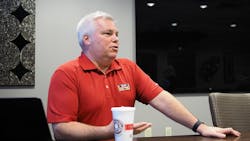One of the many beefs with trying to use truck data for better maintenance revolves the number of systems managers and technicians need to access in the course of caring for their equipment.
First, you’ve got the web portal for the specific truck, transmission or engine maker to navigate; then you’ve got the dealer’s web portals, if you need to use a truck dealer for service (necessary in many cases to maintain warranty coverage); and then you’ve got to connect all of those to your own “native” system.
Often times, trying to move data between all of those systems – even the basic stuff like vehicle identification numbers (VIN) and odometer readings – can force fleet personnel to manually enter such information.
And as we all know, errors occur that way, which then lead to what Brian Mulshine, director of operations technology and innovation for Rush Enterprises, politely calls “process failures.”
To counteract this understated but very big problem in the fleet world – information technology brains like Mulshine REALLY dislike time-consuming and inefficient processes that corrupt data – a lot of systems providers are now working together to change things up under the auspices of the Technology & Maintenance Council (TMC)
My colleague Kevin Jones penned a great story about this effort a while back; an effort Mulshine highlighted during a recent visit to the RushCare Call Center, located just down the road from the company’s headquarters in New Braunfels, TX.
“We started to rebuild our platform architecture three or four years ago with two key focal points in mind: add data transparency and improve communication between different systems,” he explained.
“Our goal is not to force customers to use a web portal: rather, we want to integrate our platform with theirs,” Mulshine said. “We are also integrating with other platforms, too, such as Decisiv, Paccar, and Navistar. That way the customer can stay within their ‘native platform’ and the data is transferred automatically between theirs and everyone else’s – there is no manual re-entry of data between systems.”
That also allows for better “two-way communication” between such systems as well, he stressed.
That can be critical in understanding what Mulshine dubbed the “rules of engagement” for customers in terms of payment requirements, use of specific inspection forms, etc. “We create a profile for each customer in our system so we know their rules,” he explained. That’s critical to share among service providers as well.
Mulshine added that Rush and other information system operators have been working TMC to create “standards” for data transfers for about two and half years now.
It’s also an effort that is part and parcel of expanding the company’s RushCare Service Connect offering introduced earlier this year, he emphasized; a system that’s poised to grow with some new features down the road.
Another neat twist to the RushCare system is that it uses the Microsoft Angular platform. “That means that our web display page is automatically resized for mobile phones and tablets so no ‘app’ in needed,” Mulshine said.
Yet he emphasized that the application program interfaces or “APIs” within Rush’s system are far more important than the “visuals” in many ways, specifically because APIs are what “let you have information in your own native system.”
All well and good, of course, but why show off such technological capabilities in a human-based call center?
It harkens back to something W. M. "Rusty" Rush, chairman, CEO and president of Rush Enterprises, noted in an interview this week: that trucking is still a relationship-based business, even though it is becoming more “data-driven.”
To that end, then, Mulshine stressed that a vital role remains to be played by the 18 RushCare Service Agents manning the company’s call center (located in a facility dubbed “the annex.”)
“We need to get the call, get the right parts, and get experts on the line; we get one shot at it,” Mulshine said.
Having a human being on the phone (one who is multilingual too; Rush has several such agents in its call center) helps navigate those often tricky “real world” details that computers sometimes just can’t figure out. For example, there’s a “weather screen” among the bank of TVs on the call center wall (it looks more like an air traffic control room, actually) so agents can quickly assess if poor conditions might affect part delivery or mobile service arrival times.
And human beings still remain the most adaptable and flexible “thinking machines” on Earth, too, which is a great trait when you’re a 100-plus national dealership network handling all manner of trucks – and not just the ones you sell.
“Every brand of truck is brought to us, so we need to be able to work on any brand of truck and keep them all up and running,” Mulshine stressed.
With better integration of maintenance systems across the industry, hopefully that will only become easier.





